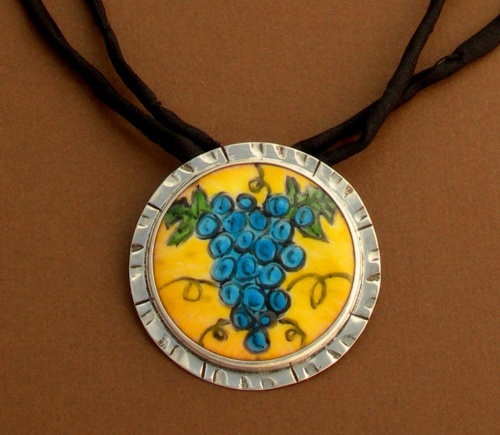Materials: Copper, Enamel
Dimensions: 1.25" in diameter
Julie Glassman
Julie Glassman Fine Art Jewelry
Grand Junction, CO. USA
As with most young children, those little things that shimmered and sparkled always caught my eye. It just so happened that shiny glass beads captured my imagination more than any of the toys in my toy chest. There was nothing I loved more than running my fingers through vintage necklaces passed down to me by one of my grandmothers. As I grew, it wasn't long before I began disassembling them and started making my very own jewelry creations using fishing swivels.
By the time I was a teenager, my interest in jewelry design peaked and my mother enrolled me in a jewelry making class one summer. On my very first day in class, I made a soldered twisted wire ring. From that moment on, I knew that I wanted to be a jewelry designer. I even told my mother as much as I burst happily into the house that day after class. I was fortunate in that my high school was only one out of ten in the country with an advanced art program. I studied jewelry design, clay sculpture and AP studio art while in high school and majored in jewelry design at the college of my choice, The Fashion Institute of Technology.
Empowered with a degree in studio jewelry and gems, I sought to broaden my horizons by mastering the technique of cloisonné enamel. One of my first creations was an enameled evil eye pendant. The symbolism was poignant in that I was suffering much tumult at that point in my life. To this day, my evil eye jewelry creations are my most popular.
Each one of my jewelry creations are handmade from my home studio nestled within the stunning landscape of western Colorado. Each one of my pieces tells a story of its own and will illuminate your very being from the moment you wear it.
The exhibition explores metal works whose primary theme is color embraced as their primary visual focus, whether that be using colored materials, exploring creating colored surfaces, or encasing the object in color.
As the world's largest jewelry related internet site, Ganoksin strives to develop exhibitions showcasing work from around the world. This exhibition was open to all metalsmiths, professional and amateur, advanced and beginner.
In total 303 artists contributed 814 show pieces for the permanent online exhibition.
The exhibition was curated by Beth Wicker, President of the North Carolina Society of Goldsmiths in the United States, and Adjunct Instructor at Northeastern Technical College in South Carolina. Director of the exhibition is Hanuman Aspler, founder of The Ganoksin Project, the world's largest internet jewelry site.
Hue is one of the primary properties of color, it refers to the place the color occupies on the visual spectrum. Humans have used hues throughout time, to create cave paintings, to decorate themselves, their clothing and their housing.
Different hues have taken on different meanings throughout time. Gold traditionally has been a color of purity - the metal gold is relatively unchangeable, and the hue of gold has come to stand for gods and goddesses, for royalty, for durability and for purity. Red has often meant love, or passion. Hues often reflect the meaning of the seasons, with pastels referring to spring and the burst of new life after the pale hues of winter. Summer is reflected in vibrant, deep hues, followed by the browning of hues in the fall as plants go to seed and die, and the land turns fallow.
The worth of a hue has often been tied to what is necessary to make the pigment that creates the hue, and the expensive involved in the process. Often created from crushed stones that had to be mined and carried by caravan over thousands of miles, or from fermented roots of plants only grown in certain areas, or the carapaces of rare insects - the creation of hue in a way that could be used by man was an involved and generally expensive process.
In today's world metalsmiths have access to perhaps the widest range of materials and hues in the history of man - and in some of the most affordable ways ever.
This exhibition celebrates hue - color - as an integral, inherent element of the work. We talk of the "richness" of color, and examples of this abound here. One expects hues from the colors of gemstones used in metalsmithing, but we also have hues from some less expected places. Glass enamels are an ancient way of adding color, as are a variety of patinas. Today's artists also use synthetic man-made materials to add color in ways that didn't exist a century ago.
We invite you to enjoy this celebration of hue, and the ways hues and their use have changed over time.
